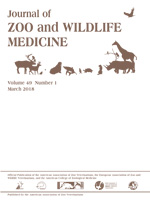Chlamydiaceae bacteria infect many vertebrate hosts, and previous reports based on polymerase chain reaction (PCR) assays and serologic assays that are prone to cross-reaction among chlamydial organisms have been used to describe the prevalence of either DNA fragments or antibodies to Chlamydia spp. in wild raptorial populations. This study reports the PCR-based prevalence of Chlamydiaceae DNA that does not 100% match any avian or mammalian Chlamydiaceae in wild populations of hawks in California Buteo species. In this study, multimucosal swab samples (n = 291) for quantitative PCR (qPCR) and plasma (n = 78) for serology were collected from wild hawks. All available plasma samples were negative for antibodies using a C. psittaci–specific elementary body agglutination test (EBA; n = 78). For IgY antibodies all 51 available samples were negative using the indirect immunofluorescent assay. The overall prevalence of Chlamydiaceae DNA detection in wild Buteo species sampled was 1.37% (4/291) via qPCR-based analysis. Two fledgling Swainson's hawks (Buteo swainsoni) and two juvenile red-tailed hawks (Buteo jamaicensis) were positive by qPCR-based assay for an atypical chlamydial sequence that did not 100% match any known C. psittaci genotype. Positive swab samples from these four birds were sequenced based on the ompA gene and compared by high-resolution melt analysis with all known avian and mammalian Chlamydiaceae. The amplicon sequence did not 100% match any known avian chlamydial sequence; however, it was most similar (98.6%) to C. psittaci M56, a genotype that is typically found in muskrats and hares. Culture and full genome sequence analysis of Chlamydia spp. isolated from diseased hawks will be necessary to classify this organism and to better understand its epizootiology and potential health impact on wild Buteo populations in California.
How to translate text using browser tools
1 March 2018
ATYPICAL CHLAMYDIACEAE IN WILD POPULATIONS OF HAWKS (BUTEO SPP.) IN CALIFORNIA
Charlene Luján-Vega,
Michelle G. Hawkins,
Christine K. Johnson,
Christopher Briggs,
Chris Vennum,
Peter H. Bloom,
Joshua M. Hull,
Carolyn Cray,
Denise Pesti,
Lisa Johnson,
Paula Ciembor,
Branson R. Ritchie
ACCESS THE FULL ARTICLE
Buteo spp.
Chlamydiaceae
EBA
genotype
IFA
qPCR





